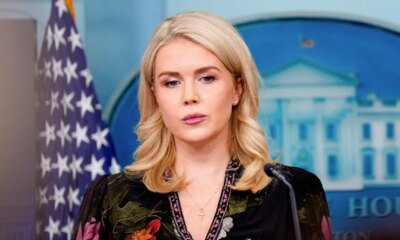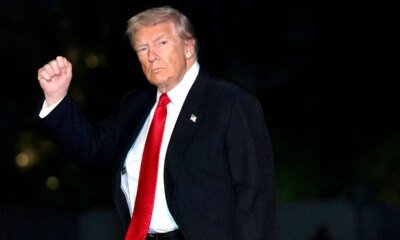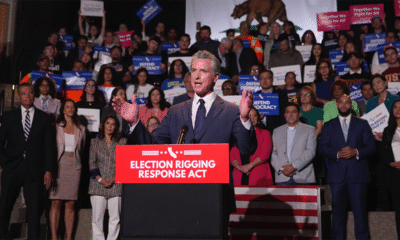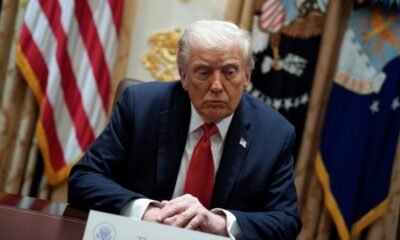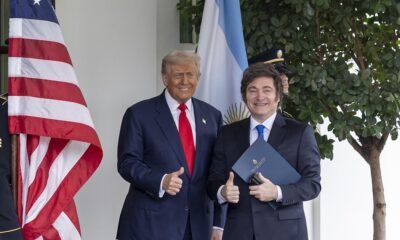INTERNACIONAL
Trump touts ‘12 out of 10’ meeting with Xi, downplays reports of Venezuela strikes

NEWYou can now listen to Fox News articles!
President Donald Trump spent the week in Asia meeting with other global leaders, including Chinese President Xi Jinping, while his administration ramped up its attacks against alleged drug boats in Latin America.
Trump met with Xi Thursday in South Korea, where the two hashed out a series of agreements concerning trade. Specifically, Trump said he agreed to cut tariffs on Chinese imports by 10% — reducing the rate to from 57% to 47% — because China said it would cooperate with the U.S. on addressing the fentanyl crisis.
Additionally, Trump said that he would not move forward with imposing an additional 100% tariff on Chinese goods that were expected to kick in Saturday. Trump threatened the steep hike after China announced in October it would impose export controls on rare earth magnets, which he said China had agreed to postpone by a year.
Afterward, Trump described the meeting as a massive success, and signaled that a broader trade deal between the two countries would be signed shortly.
TRUMP, XI MEET IN EFFORT TO RESOLVE TRADE TENSIONS SPARKED BY US TARIFFS
President Donald Trump shakes hands with Chinese President Xi Jinping as they hold a bilateral meeting at Gimhae International Airport, on the sidelines of the Asia-Pacific Economic Cooperation (APEC) summit, in Busan, South Korea, Oct. 30, 2025. (Evelyn Hockstein/Reuters)
«Zero, to 10, with 10 being the best, I’d say the meeting was a 12,» Trump told reporters after meeting with Xi. «A lot of decisions were made … and we’ve come to a conclusion on very many important points.»
From China’s point of view, Xi said afterward the two countries should work together and complete outstanding tasks from the summit for the «peace of mind» of China, the U.S., and the rest of the world.
«Both sides should take the long-term perspective into account, focusing on the benefits of cooperation rather than falling into a vicious cycle of mutual retaliation,» Xi said, according to a state media report on the meeting.
TRUMP ANNOUNCES MEETING WITH XI JINPING AT SOUTH KOREA APEC SUMMIT SCHEDULED FOR NEXT MONTH
Additionally, Trump announced on the Asia trip, which also included stops in Malaysia and Japan, that he would instruct the U.S. to revive nuclear weapons testing —upending decades of precedent on nuclear policy, as the U.S. has not conducted nuclear weapons testing since 1992. The announcement also left lawmakers, experts and military personnel wondering what he meant since no other country has conducted a known nuclear test since North Korea in 2017.
China’s and Russia’s last known tests go back to the 1990s, when Russia was still the Soviet Union.
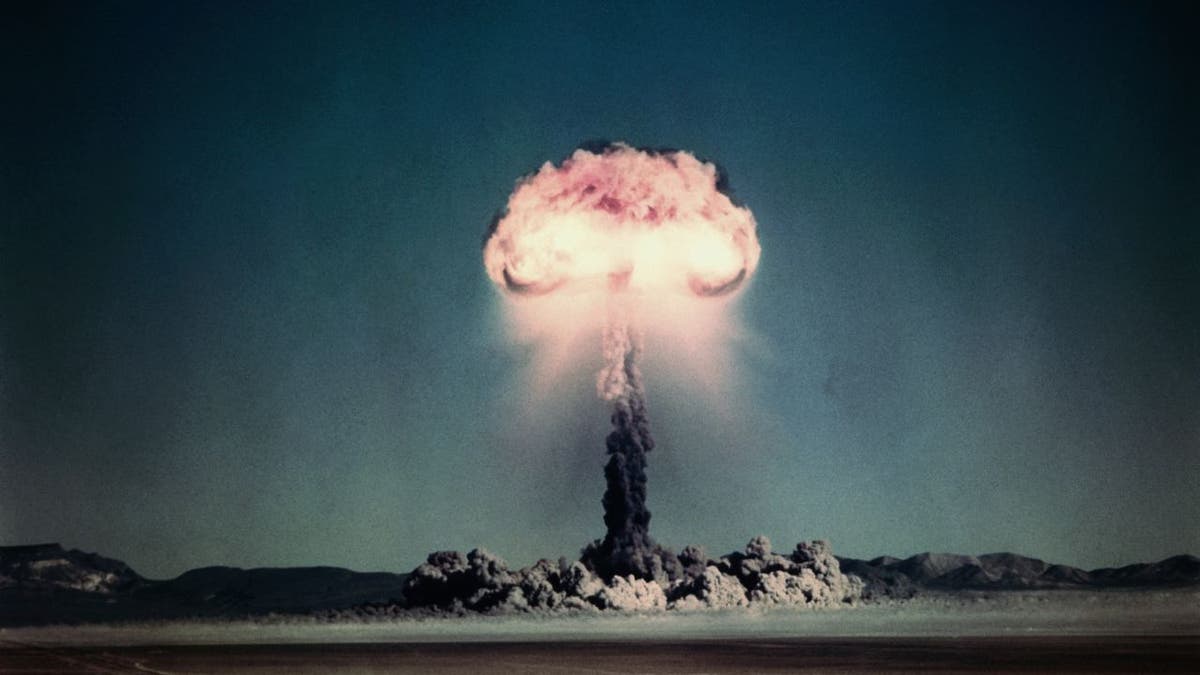
A mushroom cloud rises from a nuclear weapon test during Operation Tumbler-Snapper. Over two thousand Marines witnessed the event, which was conducted in 1952 at the Nevada Proving Ground. (Getty Images)
The White House did not provide comment to Fox News Digital. The Pentagon did not respond to a request for comment.
TRUMP CLAIMS ASIA TOUR RETURNED ‘TRILLIONS’ TO US AHEAD OF CRITICAL MEETING WITH CHINA’S XI
However, experts are aligned that Trump likely meant he would instruct the U.S. to either increase its testing of nuclear-powered weapons systems or conduct tests of low-yield nuclear weapons.
Vice President JD Vance told reporters Thursday that Trump would continue to work on nuclear proliferation, but said testing would be done to guarantee weapons are working at optimal capability.
«It’s an important part of American national security to make sure that this nuclear arsenal we have actually functions properly,» Vance said. «And that’s part of a testing regime. To be clear, we know that it does work properly, but you got to keep on top of it over time. And the president just wants to make sure that we do that with his nation.»
TRUMP THREATENS ‘MASSIVE’ CHINA TARIFFS, SEES ‘NO REASON’ TO MEET WITH XI
The Trump administration also stepped up its campaign against drug cartels in Latin America, totaling at least 14 strikes against alleged drug boats in the region.
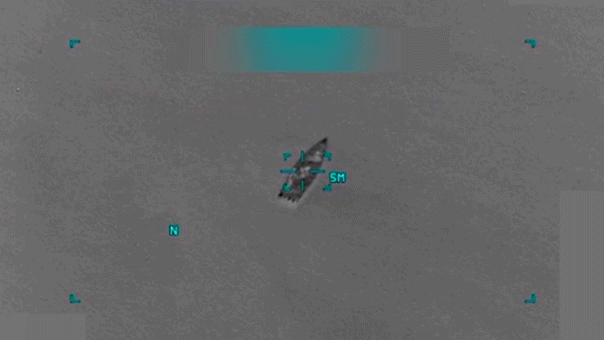
The U.S. killed six alleged drug traffickers on a boat in international waters near Venezuela, President Donald Trump announced Oct. 14, 2025. (realDonaldTrump/Truth Social)
Secretary of War Pete Hegseth announced Tuesday that the U.S. had conducted three strikes against four vessels in the Eastern Pacific, and Hegseth announced Wednesday another strike had also been conducted in those waters.
But the White House dismissed reports Friday that the Trump administration had identified and was poised to strike military targets within Venezuela imminently. Trump later told reporters that he hadn’t determined whether he would conduct strikes within Venezuela.
Lawmakers — including some Republicans — have pressed for more answers on the strikes, and have questioned if they are even legal. For example, Sens. Adam Schiff, D-Calif., Tim Kaine, D-Va., and Rand Paul, R-Ky., spearheaded a war powers resolution that would prohibit U.S. armed forces from engaging in «hostilities» against Venezuela.
CLICK HERE TO DOWNLOAD THE FOX NEWS APP
«The Trump administration has made it clear they may launch military action inside Venezuela’s borders and won’t stop at boat strikes in the Caribbean,» Schiff said in an Oct. 17 statement.
The Associated Press contributed to this report.
white house,donald trump,xi jinping,china,jd vance
INTERNACIONAL
Luigi Mangione: cómo un tiroteo inspiró memes, debates y devoción en la cultura estadounidense

El tiroteo ocurrido en diciembre pasado, en el que presuntamente Luigi Mangione, un joven desilusionado con el sistema, disparó contra el director ejecutivo de United Healthcare, Brian Thompson, en casi cualquier otra época habría sido considerado una aberración. En Estados Unidos en 2025, se transformó en un meme, un movimiento y una prueba moral.
En Luigi, John H. Richardson, un periodista experimentado, indaga cómo ocurrió esto, en un libro que es parte investigación, parte radiografía cultural. Reconstruye el trayecto de Mangione desde abanderado y tecnólogo preocupado por el clima, hasta el denominado “San Luigi” famoso en TikTok, cuya imagen aureolada hoy circula en bolsas ecológicas y tatuajes. La pregunta central del libro es una que Estados Unidos no deja de hacerse tras la cantidad creciente de tiroteos y asesinatos políticos: ¿debemos juzgar a estos autores como asesinos, como mártires justos o como espejos culturales?
Los capítulos iniciales son los más logrados. Richardson comienza con Luigi en una playa de Waikiki. Es un joven programador brillante leyendo historia social y, finalmente, el manifiesto del Unabomber. Luego, el relato se expande hacia la historia de la tecnofobia y la alienación digital en Estados Unidos.
Las similitudes con Ted Kaczynski —con quien Richardson mantuvo correspondencia durante años y sobre quien ha escrito en profundidad— se vuelven evidentes: la precisión intelectual, el desprecio por los sistemas, el paso de la crítica al extremismo.

Pero Luigi también trata sobre el resto de nosotros: el carnaval instantáneo de las redes sociales que convierte la violencia real en espectáculo participativo. Horas después del tiroteo, Internet había producido una avalancha de opiniones, memes y productos, que a menudo reproducían las palabras que Mangione grabó en sus balas: “Negar”, “Defender” y “Depone”. Se percibe algo reconociblemente estadounidense: una mezcla de ironía y desesperación que difumina los límites morales.
Richardson observa esos momentos con precisión. Entiende que el fenómeno Luigi no se reduce a un agravio político, sino que involucra también el placer de la transgresión en una sociedad que vende la indignación como entretenimiento.
No obstante, la fuerza del libro a veces depende demasiado de las propias superficies que describe. Richardson basa gran parte de su relato en material público —hilos de Reddit, reacciones en YouTube, campañas en línea— y menos en entrevistas directas con personas del entorno de Mangione. Se oyen más voces de espectadores digitales que de quienes conocieron al protagonista. Ante la ausencia de estos detalles personales, el resultado se percibe cuidadosamente curado pero distante en lo emocional.
Quizás esto resulte inevitable para un libro escrito bajo presión sobre una historia que aún evoluciona. El juicio de Mangione está pendiente y es probable que muchos de sus amigos y familiares tengan órdenes de silencio judicial. Pero ese vacío lleva a Richardson a apoyarse en la autoridad reciclada de otros, en especial de Kaczynski.

La correspondencia con el Unabomber, que fue clave en los trabajos anteriores de Richardson, reaparece aquí como el andamiaje moral e intelectual del libro. Kaczynski se convierte en el mentor fantasmal que explica la lógica de la revuelta tecnológica.
Falta una exploración más profunda sobre por qué el acto de Luigi resuena ahora, en unos Estados Unidos donde denegaciones algorítmicas de atención médica chocan con la difusión algorítmica del resentimiento y la desesperanza. Sin esa conexión, el paralelismo entre los atentados antiindustriales de Kaczynski y el presunto tiroteo anticorporativo de Mangione parece más asociativo que analítico.
Richardson busca que veamos la continuidad entre los ecoterroristas de los años noventa y los aceleracionistas digitales de hoy. Pero las fuerzas contemporáneas que impulsan “Luigi” (deuda estudiantil, trabajo precario, medicina privatizada, radicalización en línea y las redes sociales) son tanto económicas y psicológicas como tecnológicas. Queda la pregunta sobre por qué estas ideas encuentran nuevo arraigo en una economía de la salud donde el sufrimiento es privatizado e invisible. En momentos clave, el libro sugiere esta complejidad, pero no llega a ahondar en ella.
Donde Richardson acierta es vinculando el asesinato con la crisis más amplia de atención en Estados Unidos. Argumenta que el tiroteo obligó al público a enfrentar cómo el daño moral se ha integrado en la economía de la salud. Relata cómo la indignación por las prácticas de las aseguradoras creció tras el asesinato. Los directivos contrataron equipos de seguridad privados cuando encuestas reflejaron que un porcentaje sorprendente de jóvenes consideraba “aceptable” el acto.

Estas secciones resultan inquietantes e incómodas. Richardson capta la sensación de que la violencia de Luigi desnuda una fibra sensible en la política estadounidense: la impresión de que nadie en el poder escucha hasta que alguien con un arma impone el tema. Recuerda que un sistema percibido como depredador será finalmente enfrentado no solo por protestas, sino por anomia o nihilismo.
Otra línea del libro —la fascinación cultural con la violencia justiciera— resulta alarmante. Richardson documenta cómo la imagen de Mangione pasó de ficha policial a ícono. Presentadores nocturnos bromeaban sobre que era “el presunto asesino más atractivo del año”. Richardson lo llama “la energía de una cultura en cambio”, pero la frase tiene doble filo: también es la energía de una cultura que ha perdido su brújula moral.
Richardson acierta al presentar Luigi como una historia estadounidense sobre armas centrada en el hecho de que un sector importante de la población se siente “desesperado por liberarse”, como escribe el propio Richardson, de la impotencia e indignación ante el statu quo. Pero podría profundizar mucho más en las continuidades y fracturas entre salud pública, violencia política y armas, y las incómodas contradicciones que surgen cuando las posiciones antifuego chocan con los relatos ideológicos.

Richardson escribe con elegancia. Su cobertura del revuelo mediático, los editoriales enfrentados, la manipulación partidaria, los videos de influencers, es precisa y a veces irónicamente graciosa. Pero pese a su pulcritud, “Luigi” ofrece poco trabajo de campo propio. No se percibe el peso del mundo de Mangione antes ni después de su caída. Esas ausencias importan porque son las que distinguen al periodismo del collage.
En sus momentos más logrados, “Luigi” nos obliga a enfrentar preguntas que trascienden un hecho de violencia. ¿Qué ocurre cuando los sistemas diseñados para sostener la vida se perciben como mecanismos que lucran con el sufrimiento? ¿Qué significa que los estadounidenses encuentren catarsis moral en la venganza? La inquietante posibilidad que plantea “Luigi” es que la línea entre protesta y espectáculo, revolución y venganza, se ha desdibujado por completo.
El libro de Richardson tal vez no resuelva la cuestión definitiva sobre si su protagonista es un héroe, un criminal o una víctima. Pero deja una más urgente: ¿Qué dice de Estados Unidos que ya no podamos distinguir la diferencia?
Fuente: The New York Times
INTERNACIONAL
Socialist shockwave: Zohran Mamdani stuns NYC as voters hand power to Democrats’ far-left flank

NEWYou can now listen to Fox News articles!
The Fox News Decision Desk has projected that New York City will elect Democratic Assemblyman Zohran Mamdani as its next mayor. The self-described democratic socialist toppled former Gov. Andrew Cuomo in a contentious fight for the future of New York City — and possibly the direction of the Democratic Party.
Mamdani, the 34-year-old Ugandan-born state assemblyman from Queens, triggered a political earthquake when he declared victory in New York City’s Democratic mayoral primary in June, pulling an upset over a former governor who was widely expected to win the party’s nomination.
He has since been catapulted onto the national stage, teaming up with progressive power duo Sen. Bernie Sanders, I-Vt., and Rep. Alexandria Ocasio-Cortez, D-N.Y., to rally New York City voters for his affordability agenda, which includes ambitious campaign promises like rent freezes, fast and free buses, city-run grocery stores and free childcare.
It’s a race that President Donald Trump himself has been watching closely, labeling Mamdani a «100% Communist Lunatic» and «My little communist» — monikers Mamdani has rejected. On the eve of Election Day, Trump endorsed Cuomo and floated cutting federal funds to New York City if Mamdani won.
FINAL STRETCH: MAMDANI’S LARGE LEAD SHRINKING AS CUOMO GAINS GROUND IN NYC MAYORAL RACE
NYC mayoral candidate Zohran Mamdani briefly speaks with reporters as he leaves the Dirksen Senate Office Building on July 16, 2025, in Washington, D.C. (Michael M. Santiago/Getty Images)
In the days leading up to the election, Mamdani vowed to use the «bully pulpit» and the judicial system to fight back against Trump’s «threats.»
«Donald Trump may speak as if it is his decision, but this is money that this city is owed. This is money that we will expect to collect,» Mamdani said Monday.
CUOMO CLOSES GAP ON MAMDANI AS NYC MAYOR RACE TIGHTENS DRAMATICALLY IN NEW POLL
Mamdani’s primary success exposed a divide within the Democratic Party, which suffered big losses up and down the ballot last year and has since struggled to put up a united front against the Trump administration without clear party leadership.
Cuomo resigned from office in 2021 in the face of multiple controversies, including several sexual harassment claims, which he has denied. After losing the primary he was expected to win, Cuomo challenged Mamdani as an Independent candidate in the general election, and has since charged Mamdani of being more a socialist than a Democrat.
«The truth is, there’s a quiet civil war going on in the Democratic Party right now,» Cuomo told Fox News last week. «You have an extreme left. Radical left. Bernie Sanders, AOC — Mamdani is just the banner carrier for that movement — versus the mainstream moderate Democrats. They now call me moderate. They used to call me liberal. Now, I’m a moderate because the whole party shifted.»
New York Democrats were reluctant to endorse Mamdani’s mayoral campaign after he secured the Democratic nomination.
Senate Minority Leader Chuck Schumer refused to endorse Mamdani, despite telling reporters he has a «good relationship with him» and that they are «continuing to talk.» Mamdani was arrested for protesting the war in Gaza and calling for a ceasefire outside Schumer’s home in Brooklyn in 2023.
House Minority Leader Hakeem Jeffries gave an 11th-hour endorsement for Mamdani after months of equivocating. The announcement came the day before early voting began.

Independent candidate former New York Gov. Andrew Cuomo speaks during a mayoral debate, Thursday, Oct. 16, 2025, in New York City. (AP Photo/Angelina Katsanis, Pool)
Gov. Kathy Hochul, D-N.Y., endorsed Mamdani’s campaign in September and later joined him on the campaign trail. When pressed about whether Mamdani would endorse Hochul, he refused to affirm his support for the sitting governor.
Hochul will be critical to Mamdani’s plan to raise taxes on corporations and the top 1% of New Yorkers to pay for his radical campaign agenda, as a tax hike would require state approval.
The governor has maintained that she will not raise taxes, which earned her some heckling at a recent Queens rally, when Mamdani’s supporters shouted, «Tax the rich!»
Mamdani has faced a relentless news cycle since securing the Democratic nomination.
Cuomo and Republican nominee Curtis Sliwa, the founder and CEO of the Guardian Angels, have said that Mamdani would not do enough to protect Jewish New Yorkers if elected mayor.
Mamdani refused to condemn the term «globalize the intifada» during the primary, widely considered a call to violence against Jews. He has since committed to discouraging others from using the term.

New York City mayoral candidate Zohran Mamdani and Gov. Kathy Hochul hold hands on stage as they attend a «New York is Not For Sale» rally at Forest Hills Stadium, in the Queens borough of New York City, on Oct. 26, 2025. (Reuters/Eduardo Munoz)
Weeks before Election Day, a slate of prominent New York City rabbis joined more than 650 rabbis nationwide to sign «A Rabbinic Call to Action: Defending the Jewish Future,» asserting that Jewish Americans «cannot remain silent» on discrimination against Jewish people and citing Mamdani’s stances that are critical of Israel.
Mamdani, who is of Indian descent, will be the first South Asian and first Muslim mayor of New York City.
Religion has been a defining issue in the mayoral race, as many Jewish New Yorkers have rejected Mamdani’s positions on Israel, including his calling the war in Gaza a «genocide» and his refusal to recognize Israel as a Jewish state.
Mamdani has maintained that he «would not recognize any state’s right to exist with a system of hierarchy on the basis of race, of religion.»
When asked during last week’s mayoral debate if Mamdani has any regrets about his «long-standing» anti-Israel views, the democratic socialist affirmed his commitment to protecting Jewish New Yorkers, as he has throughout the campaign.
Mamdani has a long record of supporting the pro-Palestinian movement, including at Bowdoin College, where he founded the Students for Justice in Palestine chapter.
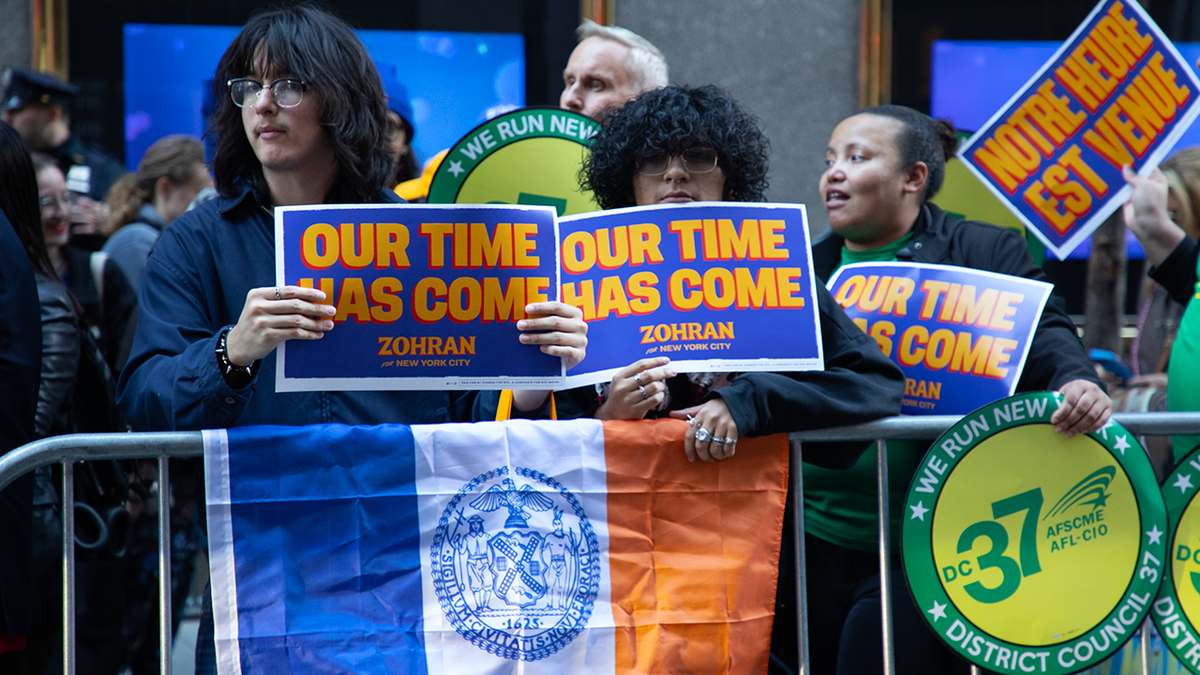
Democratic mayoral nominee Zohran Mamdani supporters gather outside 30 Rock in New York City on Thursday, Oct. 16, 2025. (Fox News Digital/Deirdre Heavey)
With weeks until Election Day, Mamdani charged his opponents and Mayor Eric Adams, who ultimately suspended his re-election campaign after staying out of the Democratic primary to run as an independent, with Islamophobia for a slew of comments made about him on the campaign trail.
Mamdani also faced criticism for his past comments about the New York City Police Department, including those comparing the NYPD to the Israel Defense Forces and calling the NYPD «racist, anti‑queer & a major threat to public safety» in 2020, among other insults.
«I’ll apologize to police officers right here, because this is the apology that I’ve been sharing with many rank-and-file officers, and I apologize because of the fact that I’m looking to work with these officers, and I know that these officers, these men and women who serve in the NYPD, they put their lives on the line every single day,» Mamdani said on Fox News.
As New York City voters began heading to the polls for early voting, billionaires, including Red Apple Media CEO John Catsimatidis and hedge fund CEO Bill Ackman, urged Sliwa to drop out of the race to consolidate support for Cuomo, but the Republican nominee refused to suspend his campaign.
Similar pressure mounted after the primary for either Cuomo or Adams to drop out to boost the anti-Mamdani vote. After Adams suspended his campaign, he ultimately endorsed Cuomo. Trump’s Justice Department dropped bribery, wire fraud and conspiracy charges against Adams earlier this year.
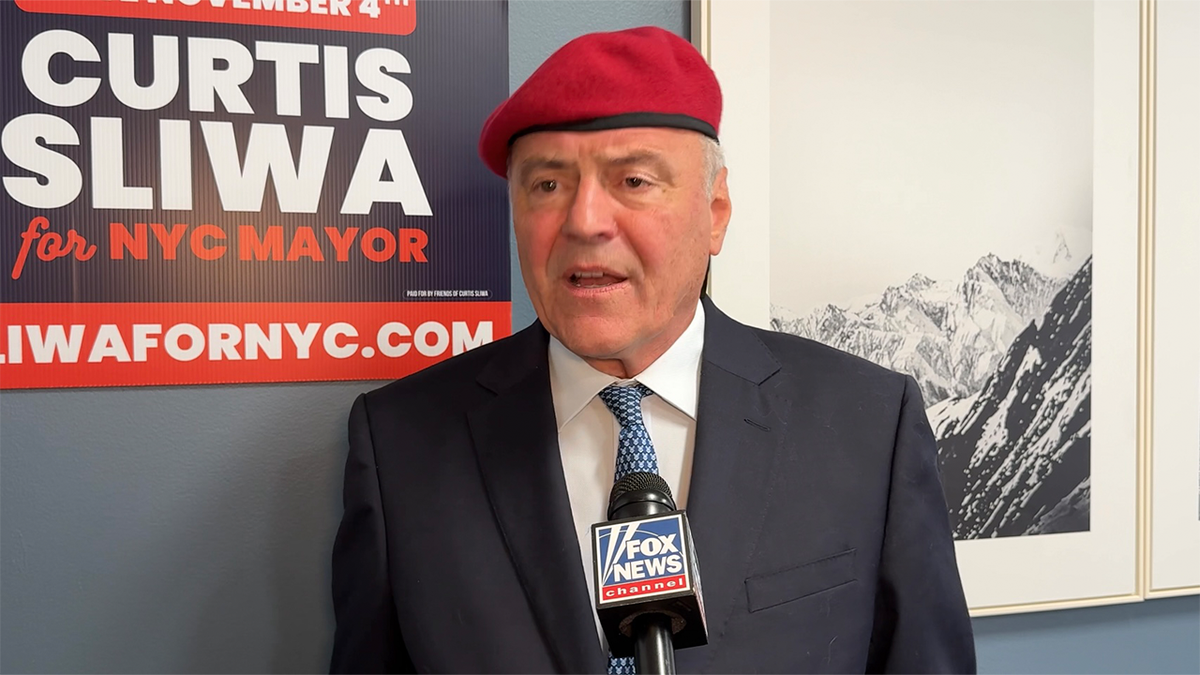
Republican mayoral nominee Curtis Sliwa is interviewed by Fox News Digital, in New York City on Aug. 18, 2025. (Paul Steinhauser/Fox News)
Mamdani will also be the first millennial mayor of the nation’s largest city.
Such was clear from the early days of Mamdani’s campaign, as he made strategic use of social media, including TikTok, to build a recognizable brand and motivate a swath of low-propensity voters.
His campaign played into the hands of an evolving – and chronically online – New York City electorate.
Scrolling through Mamdani’s social media, his TikTok and Instagram pages resemble that of a New York City influencer. From the film-like filters and consistent fonts on his vertical videos to the cameos from celebrities, including model Emily Ratajkowski and comedian Bowen Yang, Mamdani’s videos regularly amass millions of views.
During the general election, Mamdani’s campaign began collaborating with content creators, inviting New York City’s micro-influencers to a «New Media» briefing, which are typically reserved for mainstream media, and continuing to walk through the revolving door of podcast appearances, akin to such efforts by the Trump administration in 2024.
CLICK HERE TO DOWNLOAD THE FOX NEWS APP
Like Trump in 2024, Mamdani centered his mayoral campaign on affordability, vowing to deliver a New York City that voters could actually afford to live in.
Mamdani told Fox News in the final days of his campaign that he learned of a woman wearing a «MAGA for Zohran» hat at his Queens rally, eliciting Trump’s renowned «Make America Great Again» slogan.
«It tells me that no matter what your politics are, you’re feeling the same crisis, and this is a movement that looks to address that crisis» of affordability, Mamdani said. «No matter who you are, no matter where you live.»
zohran mamdani,andrew cuomo,curtis sliwa,nyc mayoral elections coverage,2025 2026 elections coverage,new york city,elections
INTERNACIONAL
Un hombre acosó a la presidenta de México, Claudia Sheinbaum, en plena recorrida en el DF
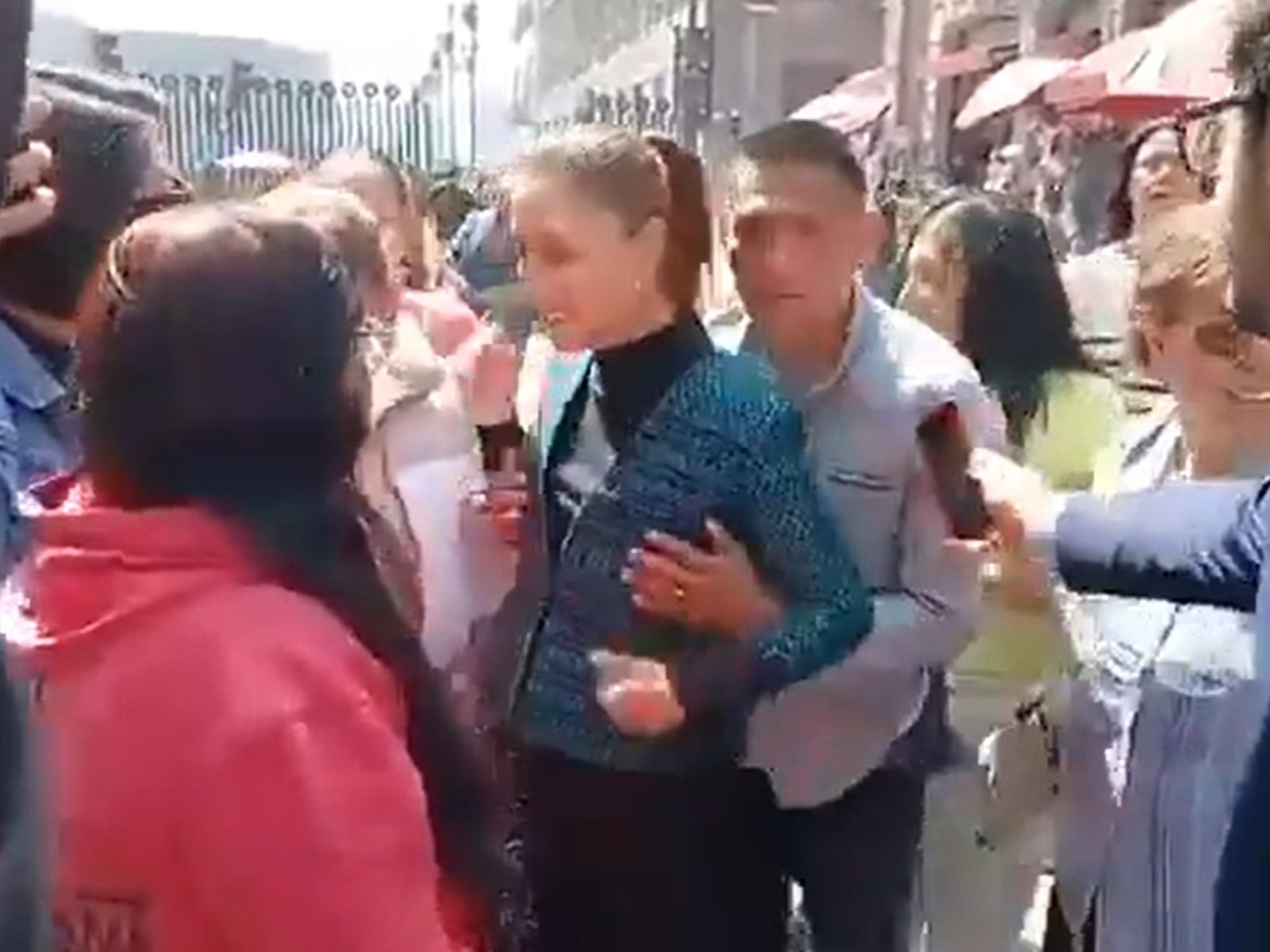
La presidenta de México, Claudia Sheinbaum, fue acosada este miércoles mientras recorría las calles del centro histórico de la Ciudad de México por un hombre que no fue identificado. El momento quedó registrado en un video, donde se ve que su escolta de seguridad no la estaba acompañando en ese momento.
Según indicaron medios locales, todo ocurrió durante el traslado de la mandataria a la Secretaría de Educación Pública (SEP) en el Centro Histórico de la Ciudad de México. Sheinbaum frenó en la calle para dialogar con algunos vecinos frente a las cámaras de televisión cuando un hombre se le acercó por detrás y le pasó un brazo sobre los hombros.
Mientras lo hacía, el hombre intentó darle un beso, pero el movimiento de la presidenta mexicana se lo impidió. Sin embargo, el sujeto continuó con sus actos y comenzó a recorrer con sus manos el cuerpo de la mandataria.
«Ey, ey, ey, ey», se escucha quejarse a Sheinbaum mientras se saca al hombre de encima. En ese momento, una de las personas que estaba grabando con un celular -y que presuntamente sería el titular de la Dirección General de Ayudantía, Juan José Ramírez Mendoza-, se mete y aparta al hombre, que insiste en su intento de abrazarla.
Marcando distancia, la mandataria le responde «nos tomamos la foto, no te preocupes». El hombre, en aparente estado de ebriedad, murmura algunas palabras que no se llegan a entender. El video concluye en ese momento y, según se indicó, esta persona no fue identificada.
Horas más tarde, se difundió en redes otro video que muestra el momento en el que, luego del ataque, la presidenta mexicana se toma igualmente una foto con su agresor. Quien sostiene el celular a modo de cámara parece ser justamente uno de los hombres que la habían defendido anteriormente.
Video
El momento en que el hombre que acosó a la presidenta de México se sacó una foto con ella
Es la misma persona que, tras ese incómodo momento y con la foto ya capturada, se interpone entre la mandataria y el hombre que la había acosado, dejándolo atrás. Sheinbaum, mientras tanto, continuó retratándose junto a vecinos del lugar.
Según indicó la prensa mexicana, el ataque ocurrió sobre la calle República de Argentina, en el Centro Histórico de la Ciudad de México. Hasta el momento, las autoridades mexicanas no se expresaron al respecto.
Más temprano, la presidenta mexicana había presentado un plan de refuerzo en la seguridad
Claudia Sheinbaum anunció más temprano, este mismo martes, una “estrategia integral” para el estado de Michoacán, en el oeste de México, en donde en los últimos días se registraron protestas que incluyeron la toma del palacio de Gobierno de Urupán, luego del asesinato del alcalde local Carlos Manzo Rodríguez, ocurrido el domingo pasado.
Fue en ese contexto que la mandataria presentó en su conferencia matutina el “Plan Michoacán por la Paz y la Justicia” con el que, según explicó, se impulsará un “reforzamiento de seguridad” bajo un “esquema integral” que incluirá la atención de las causas de la violencia.
Durante su exposición, Sheinbaum informó que se enviarán nuevos contingentes de la Guardia Nacional y agentes de la Secretaría de Seguridad federal para apoyar a la policía de Michoacán, aunque no dio cifras.
Según cifras oficiales, en septiembre Michoacán había ocupado el séptimo lugar en el número de homicidios de México, al acumular 1.024 casos en los primeros nueve meses del año.
Las autoridades estatales aseguran que en el primer semestre de este año disminuyeron 17% los homicidios en Michoacán, en comparación con el mismo período del 2024. Sin embargo, los recientes asesinatos de los alcaldes de Tepalcatepec y Tacámbaro, Martha Laura Mendoza y Salvador Bastidas; del periodista Mauricio Cruz Solís y del líder de los productores de limón de Apatzingán, Bernardo Bravo, continúan despertando preocupación.
Entre 2022 y 2024 también habían sido baleados otros cuatro alcaldes en Michoacán: Yolanda Sánchez en el municipio Cotija; Guillermo Torres en la localidad de Churumuco; César Valencia en el municipio Aguililla, y Enrique Velázquez en el municipio Contepec.

 CHIMENTOS2 días ago
CHIMENTOS2 días agoPaula Robles rompió el silencio tras las amenazas de muerte a Juanita Tinelli, su hija: “Hay otro mundo en el que sí tenemos posibilidades”

 CHIMENTOS3 días ago
CHIMENTOS3 días agoLamine Yamal contó toda la verdad sobre las infidelidades a Nicki Nicole y fue tajante: “Todo lo que está saliendo no tiene nada que ver”

 POLITICA3 días ago
POLITICA3 días agoTras los cambios de Gabinete, Milei viaja a Miami para participar de una cumbre global junto a Trump



